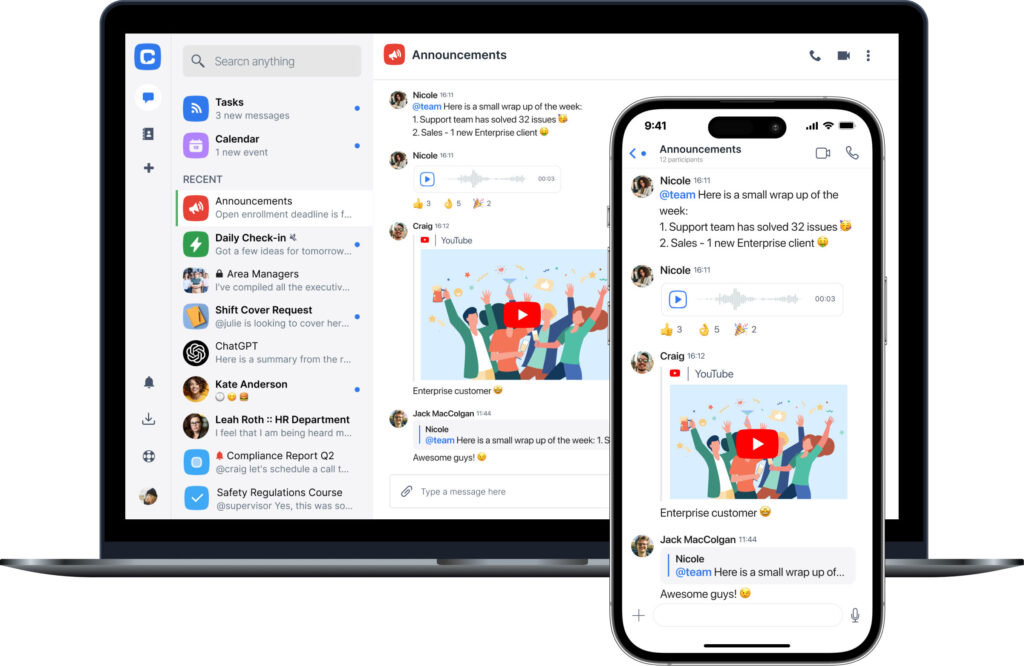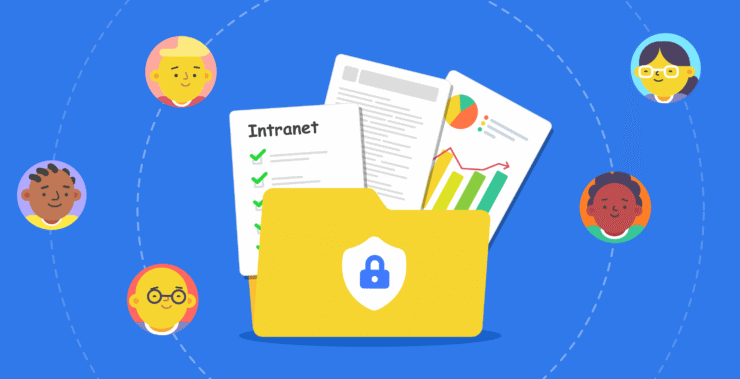Document management forms part of any thriving organisation. In a day and age when information tends to be the most valuable resource, having knowledge about how to handle data streams both effectively and safely is the priority. That’s where intranet document management systems come in. These programs not only aid in file storage organization but also make it easier to search for, share, and collaborate on files within the organization.
Intranet systems offer unique capabilities for organizing and storing a wide range of documents – everything from reports and requests to operational guidelines and company policies. More importantly, they provide robust data security, a crucial feature in today’s digital landscape.
In this article, we’ll explore how document management works within intranet systems, the benefits they offer, and provide tips for choosing and implementing these solutions, with a special focus on data security.
What is document management in intranet systems?
A document management system in an intranet is a piece of software that allows businesses to store, manage, and share documents in the organization. In comparison with traditional file systems that are mostly cloud-based or server-based, intranet systems have additional features to facilitate easier and more convenient document working.
An intranet is a private internal network shared only by a company’s employees. Document storage and management through this network offer a centralized place for all working documents with controlled access to authorized personnel.
Using these systems, you can:
- Organize and categorize documents (e.g., financial reports, guides, presentations).
- Grant access to documents to specific user groups by defining access rights.
- Manage document versions – monitor changes and ensure that everybody is using the latest version.
- Enable collaboration – multiple users can modify the same document simultaneously, speeding up workflows.
Document searching and indexing and versioning, where every change made to a document is monitored and stored, are a few of the valuable features of these systems that make the information you need readily available.
Why is document management so important?
In business, where information is capital, good document management is a key component of any successful company. Document management systems within intranet environments help to streamline processes, reduce errors, and optimize productivity. Let us examine why this is such an important component.
- Speeding up workflows: With all the documents stored in one place and shared via an intranet platform, employees don’t waste time searching for the documents they need. This is especially crucial in big companies, whose data and document quantity is massive. Easy and quick access to information helps workflows be uninterrupted and streamlined.
- Reducing errors: The consequences of working with outdated or incorrectly saved documents can be catastrophic. To give an example, using outdated reports for analysis can lead to incorrect decisions. Document management systems track and manage file versions so that all users are working on the most recent information.
- Streamlining information access: User-friendly search and indexing features allow documents to be quickly found by keywords, categories, or dates. Not only does this speed up the workflow, but it also reduces the risk of error involved with disorganized documentation. An automatic indexing system greatly improves productivity by cutting out wasted time searching for files.
- Collaboration and document sharing: Modern intranet sites make it simple to share documents, co-edit documents in real-time, and monitor changes. It improves communication and problem-solving between team members. Simple document sharing simplifies processes like report approval, creating projects, and preparing presentations.
Main features of successful document management systems on intranet networks
To make a document management system useful in an intranet system, the system needs to incorporate certain essential characteristics that ensure easy usage, give security to data, and collectively boost productivity. Let us understand the chief attributes that a system needs to include.
- Document search and indexing: Proper search functionality is needed so that the users are able to quickly find the files that they need even if they have thousands of files. A good document management system will automatically index all the documents, and users can search the documents by keyword, tags, dates, etc. This considerably speeds up procedures, saves time, and boosts productivity.
- Version control and change history: Version control will permit you to track any changes made to the documents. If multiple employees are working on the same document, the system will keep a record of changes, including who updated the file and when. The feature gives the option to roll back to an older version if needed, avoids conflicts, and keeps all members working from the most current data.
- Data security: The security of data is one of the most essential parts of document management. Intranet document management software has multi-layered security, which involves data encryption, multi-factor authentication, and access control management. These all help to block leaks of sensitive information and protect sensitive data so that only specific users can see it.
- Access control and user permissions: Each company has its own rules on who should be allowed to access what documents. An effective document management system must enable flexible access control, assignment of roles (e.g., reader, editor, administrator) and access restrictions to parts and files. This enhances security and avoids unintentional data leaks.
- Collaboration and integration with other tools: Modern document management systems also allow for multiple users to edit the same document simultaneously, in real-time. This enables collaboration between teams. It is also important that the system integrates with other business tools, such as email, calendars, or CRM systems, to create an integrated ecosystem.
Security considerations in document management
One of the most critical aspects of managing documents within intranet systems is security. With the growing number of digital threats, protecting data has become a top priority. Let’s take a closer look at key security issues to consider when managing documents in intranet networks and how to minimize risks. We’ll also share real-life examples of how to avoid common security threats.
- Data encryption: All documents transmitted or stored in an intranet system should be encrypted. This protects them from unauthorized users, even if they are intercepted by the wrong individuals. For example, imagine an employee sending a vital document via email without encryption, and it gets intercepted during transmission. To avoid such occurrences, it’s necessary to use only encrypted communication tools. Encryption must be set at the system level in a way that files are secure both while being stored and transmitted.
- Multi-factor authentication (MFA): A single password is no longer enough to guard data. MFA adds another layer of protection, which proves useful if someone tries to login using stolen credentials. For instance, if the password of a user had been stolen (for example, due to phishing), but the second authentication factor is not in the hands of the attacker, they will be unable to access the system. Enforcing MFA for all users, particularly those with access to sensitive information, is one of the most formidable security solutions.
Pro tip: Use MFA via authentication apps (like Google Authenticator) or one-time codes delivered to mobile devices. This is more secure and convenient than receiving codes via SMS.
- Access control management: It’s important to implement access rights so the employees have only access to the documents necessary to perform their jobs. Example: a sales manager mistakenly received access to financial reports, which might have resulted in a data leak. To prevent such errors, review access rights from time to time and restrict them to only what’s required.
Pro tip: Make a simple access policy following the principle of “least privilege.” This means to provide every employee with access to only that data which is immediately relevant to his or her role and responsibility.
- Audit and activity monitoring: Continuous monitoring of the activity of users is important in order to detect anomalies beforehand. For example, if a user starts downloading many documents in a short time frame, it can be a sign of attempting to exfiltrate information. Continuous auditing not just helps to block attacks but also provides transparency in handling documents.
Pro tip: Ensure that your system is capable of log analysis. Obtain users’ activity reports and review them at least monthly. This will help to detect suspicious activity, e.g., access to documents from unknown IP addresses or outside of working hours.
- Backup and recovery: Despite all the measures, there still lies a chance of data loss. For instance, there can be a system crash, and crucial information might get lost. If you haven’t saved or updated a document properly, it can bring the team’s workflow to a complete stop. In order to prevent risks, set regular data backups so that in case of data corruption or loss, you can recover information immediately.
Pro tip: Use automatic backup procedures to preserve data on a daily or weekly basis. Keep backups remotely on servers and in cloud storage to protect against local system failures.
The best intranet document management software
1. Chanty

Chanty is a team collaboration platform that brings together messaging and project management functionality. Unlike traditional document management systems, Chanty is incorporated with several cloud storage solutions and allows you to easily share and collaborate on documents within the scope of team projects.
Document sharing features:
- Integration with cloud storage providers like Google Drive, Dropbox, and Box for storing and sharing documents
- Commenting and discussing documents directly in team chats
- Simple project management with built-in tasks and reminders
Security:
- Encryption: SSL/TLS for data in transit and AES-256 for data at rest
- MFA: Provides multi-factor authentication
- Access Control: Can set permissions for channels and files at the team level
Best for: Small to medium-sized businesses and teams that need an easy solution for real-time document sharing and collaboration.
2. Google Workspace (Docs, Drive)
Google Workspace (formerly G Suite) provides cloud-based collaboration software like Google Docs, Sheets, and Drive that deliver file sharing and real-time collaboration. It is an ideal option for small and medium-sized businesses and remote teams due to its affordability and seamless integration with other Google applications.
Document sharing features:
- Real-time document collaboration
- Integration with other Google apps (like Gmail and Calendar)
- All types of documents are supported – text, spreadsheet, and presentations
Security:
- Encryption: SSL during transmission and server-side encryption
- MFA: Option to enable multi-factor authentication for added security
- Access Control: Flexible access permissions for each file or folder
Best for: Small and medium businesses, startups, and remote teams.
3. Dropbox Business
Dropbox Business offers easy cloud storage with collaboration features, access permissions, and document versioning. It is a perfect choice for small and medium-sized businesses that require a simple yet effective document-sharing method. Dropbox also integrates well with other applications to enhance workflow.
Document sharing features:
- Cloud storage to store and share documents
- Shared folders to share and collaborate on files
- View and retrieve document versions
Security:
- Encryption: AES-256 for data at rest and SSL for data in transit
- MFA: Two-factor authentication is supported
- Access Control: Folder and file level permission settings
Best for: Small to medium-sized businesses, startups, and individuals who require an easy-to-use file-sharing feature.
4. Box
Box is a cloud-based document management and collaboration platform, designed with security and compliance in mind, such as support for standards like HIPAA and GDPR. It’s ideal for companies with high-security requirements and document management requirements with workflow automation capabilities.
Document sharing features:
- Real-time collaboration and file sharing instantly
- Document syncing and access on mobile
- Integration with popular business apps like Salesforce, Google Workspace, and Microsoft 365
Security:
- Encryption: AES-256 for data at rest and SSL for data in transit
- MFA: Two-factor authentication for added security
- Access Control: Granular permissions and data protection for regulatory compliance
Best for: Medium to large-sized businesses that need strong security and regulatory compliance.
5. Zoho WorkDrive
Zoho WorkDrive is a document-sharing platform in the cloud that offers simplicity and features for teams of all sizes. Zoho offers robust real-time document collaboration, access control, and file sharing among team members. It is ideal for small and medium businesses and firms with remote teams.
Document sharing features:
- Real-time document collaboration and editing
- Organizing documents by creating folders and setting access restrictions
- Accessing documents anywhere on mobile
Security:
- Encryption: TLS for data in transit and AES-256 for data at rest
- MFA: Provides multi-factor authentication
- Access Control: Restrict access at the document and folder level, providing access to specific users only
Best for: Small to medium-sized businesses, startups, and remote teams.
Quick comparison table:
| System | Key Features | Encryption | MFA | Access Control | Suitable For |
| Chanty | File sharing, tasks, chats | AES-256, SSL/TLS | Yes | Channels, files | Small and medium businesses |
| Google Workspace | Collaboration, cloud storage | SSL, server-side encryption | Yes | Customizable access rights | Small and medium businesses |
| Dropbox Business | Cloud storage, versioning | AES-256, SSL/TLS | Yes | Folders, users | Small and medium businesses |
| Box | File sharing, mobile access, automation | AES-256, SSL/TLS | Yes | Regulatory compliance | Medium and large businesses |
| Zoho WorkDrive | File sharing, access control, mobile access | TLS, AES-256 | Yes | Folders, documents | Small and medium businesses |
How to choose the best document management system for your business
Choosing the best document management system is an important decision that depends on several factors, such as company size, document types, security needs, and budget. To help you make a fully informed decision, let’s list the key points to be taken into consideration when picking the best system for your business.
- Company size and scalability: Small businesses favor products with straightforward interfaces and easy-to-implement functionality that can easily be maintained. These kinds of systems don’t require extensive setup and training costs. For example, Chanty is not only a team communication tool but also a document management tool for small and medium businesses without adding any irrelevant complexity.
For bigger enterprises, more sophisticated and scalable solutions are required. These systems need to be integrated with other enterprise applications and need to support a large number of users and documents.
- Document types and version control: When you choose a document management system, you must consider the types of files you utilize. If your documents change often, then it is important to choose a system that includes version control as well as change tracking. Systems such as Dropbox or Google Workspace are perfect for businesses that need to track changes and collaborate in real time.
For more complex document handling tasks, such as legal or financial documents, more integrated services like Box or M-Files with other business applications might be more appropriate.
- Security and Compliance: Security is one of the most significant considerations when selecting a document management system. If your company works with sensitive information or must adhere to stringent standards such as GDPR, HIPAA, or SOC 2, it’s essential to select a solution with robust protection measures, encryption, and multi-factor authentication.
Tools such as Box provide very good security and adherence to global standards. Ensure the system also provides data backup and disaster recovery mechanisms.
- Integration with Other Apps: Consider what other tools and applications you wish to utilize along with your documents. If Google Workspace is already being utilized in your business, Google Drive can be the most suitable option for easy file storage and sharing.
Chanty is also perfect for businesses that wish to add document management in addition to other collaboration tools like Trello, Slack, or Google Docs.
- Budget: The cost factor is also important. Small and medium-sized businesses may find it more affordable to opt for cloud solutions with scalable pricing, like Google Workspace or Chanty, but larger businesses may require a more expensive but feature-rich solution like Box, which can support a larger team and specific security needs.
Conclusion
When choosing a document management system for your intranet, it’s important to understand that there’s no one-size-fits-all solution for every business. The best choice depends on company size, document types, security requirements, and integration support. It is not just a question of picking a system with the right features, but you also need to consider security risks and data retention.
In conclusion, Chanty is an excellent choice for small and medium businesses due to its simplicity and compatibility with other collaboration software. For larger businesses where security and scalability are the top priorities, solution like Box is the most appropriate. The key is to choose a system that aligns with your business needs and budget.
Remember, selecting the right document management system will not only simplify file sharing but also increase data security, which is any business’s top concern.








